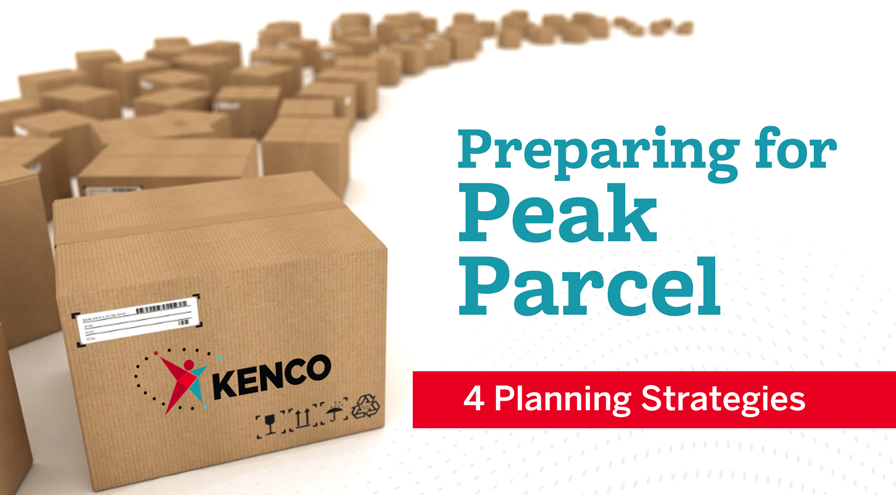Since the onset of the pandemic, parcel carriers have reported that they’re operating at peak levels year-round. Last year’s peak season presented new challenges to an overwhelmed global supply chain, and a Logistics Management survey found that 79% of supply chain stakeholders believe 2021 peak season will be busier than 2020.
When it comes to parcel shipping and logistics during this year’s peak, shippers can expect to juggle increased demand, high consumer expectations, overwhelmed carriers, higher carrier rates and penalties, and a decrease in on-time performance.
Luckily, it’s not too late for companies to tweak their strategies to optimize parcel operations during peak season this year and in the future. Check out our top four peak parcel planning strategies to implement for a successful (and less stressful) season.
- Fine-Tune Forecasting to Avoid Carrier Penalties
The past 18 months have thrown a wrench in routine forecasting and modeling. A barrage of extenuating circumstances created an unprecedented 2020 peak season, making it near-impossible to accurately forecast using traditional historical models and trends. As a result, businesses were ultimately making their best educated guesses regarding their peak order volumes. Now, shippers should lean on forecasting lessons learned from 2020, as last year’s peak season will likely be a stronger indicator of what to expect this year than previous seasonal data.
This year, accurate forecasting is vital not only for inventory (if regular inventory is even available!), but also to effectively plan your transportation needs. Businesses will need to closely align their needs with carrier capabilities—a distinct challenge in 2021 as capacity constraints continue to burden the industry and supply chain at large. In prior years, parcel carriers were more easily able to ramp-up operations to meet the needs of the typical seasonal fluctuations. In the current environment, carriers are carefully allocating capacity and cautioning their customers that packages exceeding allotted allocation could get left on the dock.
This all creates an ultra-competitive landscape in which businesses that go over or under their predicted forecasts can face record-high carrier surcharges and, in some cases, penalties. Therefore, it will be critical for businesses to continually fine-tune their forecasts based on real-time market data. Constant carrier communication may also help avoid some of the premium fees or penalties during peak. If the carriers have enough of a heads-up to re-work their operations to accommodate an overage or shortage of volume, they may be more willing to negotiate on the fees.
- Level-Set Customers’ Expectations
Shippers must understand their parcel capabilities early to set expectations accordingly. These decisions will hinge on the product type, profit margin, customer base, and more. Businesses should determine whether they can provide “fast and free” shipping throughout peak or if they will need a different approach, such as charging for expedited shipping, given rising costs and demand.
Whatever the decision, it will be important to be transparent with consumers. Like last year, skyrocketing customer expectations continue to compound ongoing supply chain challenges. Therefore, now is the time to start to gently level-set consumer expectations and help guide their order behavior.
Similar to previous years, shippers should set deadlines for consumers to guarantee arrival dates. Businesses may need to build extra padding into their shipping timelines compared to pre-pandemic years. For example, businesses could add a day or two of cushion to the carriers stated “last day to ship to receive by Christmas” to ensure customer demands are met (and potentially exceeded). If they have the systems in place, they could target extra cushioning to zip codes or areas where carriers have struggled to perform. If the pandemic taught us anything, it’s the importance of planning for the unknown. A pleasantly surprised customer is much better than one who may not understand that Santa’s sleigh was just too full this year.
- Lean into Regional Parcel Carriers
Regional carriers are a great option to expand your transportation network and alleviate capacity constraints. The right regional partner can provide cost benefits as well as quality delivery service and competitive transit times. Multi-sourcing and having a diverse carrier base are great ways to add resilience to your logistics network.
Unfortunately, if you’re just now considering working with a regional carrier for peak season 2021, you’re probably too late to the party. In planning for the upcoming season, regional options are finding themselves at maximum capacity right alongside national carriers like FedEx and UPS.
For shippers that want to have a successful peak season, carrier diversification conversations should start now or early in the new year. Regional carriers take pride in their customer relationships, so it’s important to cultivate a relationship year-round instead of ringing them in peak season’s eleventh hour.
As always, do your research and seek guidance from logistics professionals. Whether or not a regional carrier is right for your operation will depend on your shipping volume, where you are shipping, what you are shipping, who your customer base is, and several other factors.
- Engage a Trusted 3PL Partner
In an especially challenging peak season landscape, it will be instrumental to engage a proven 3PL to help create a customized, data-centric strategy. With a finger on the pulse of what’s happening in the market, the right partner can assess your network holistically.
Kenco has knowledgeable, experienced teams specializing in all things transportation—whether it’s parcel, LTL, or truckload—that can help digest all of your businesses’ data, inventory, and forecasts while creating and executing a plan for a successful peak season. Kenco can help cut costs and shipping times during peak by negotiating tricky carrier contracts, advising on carrier diversification, housing inventory in more localized warehouses, fine-tuning forecasts and so much more.


